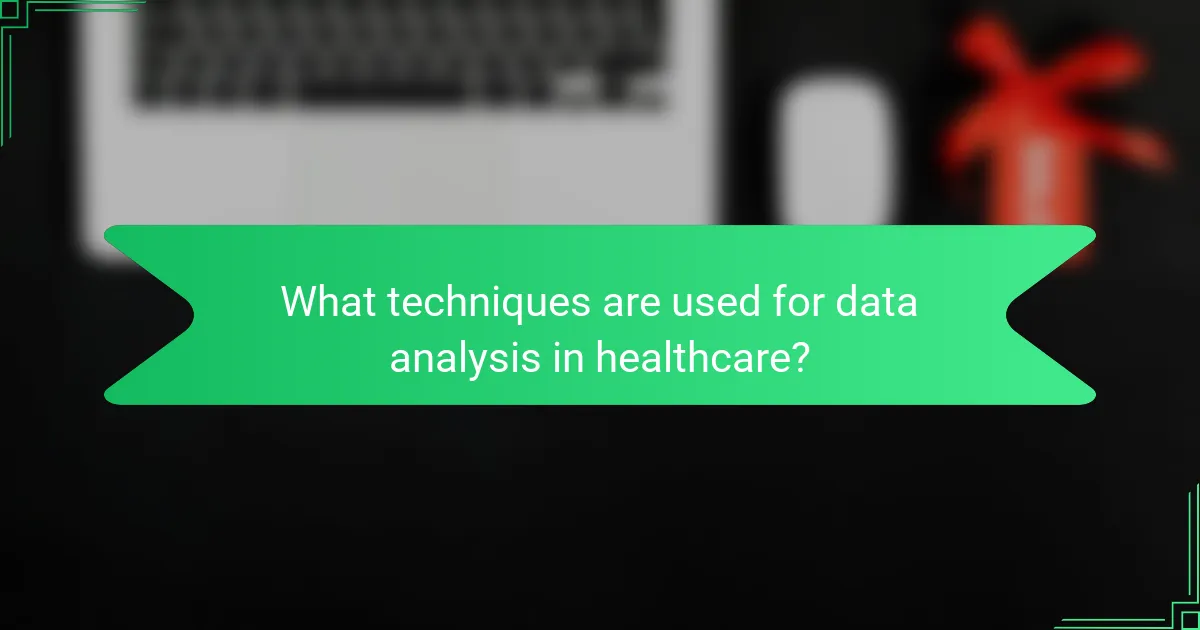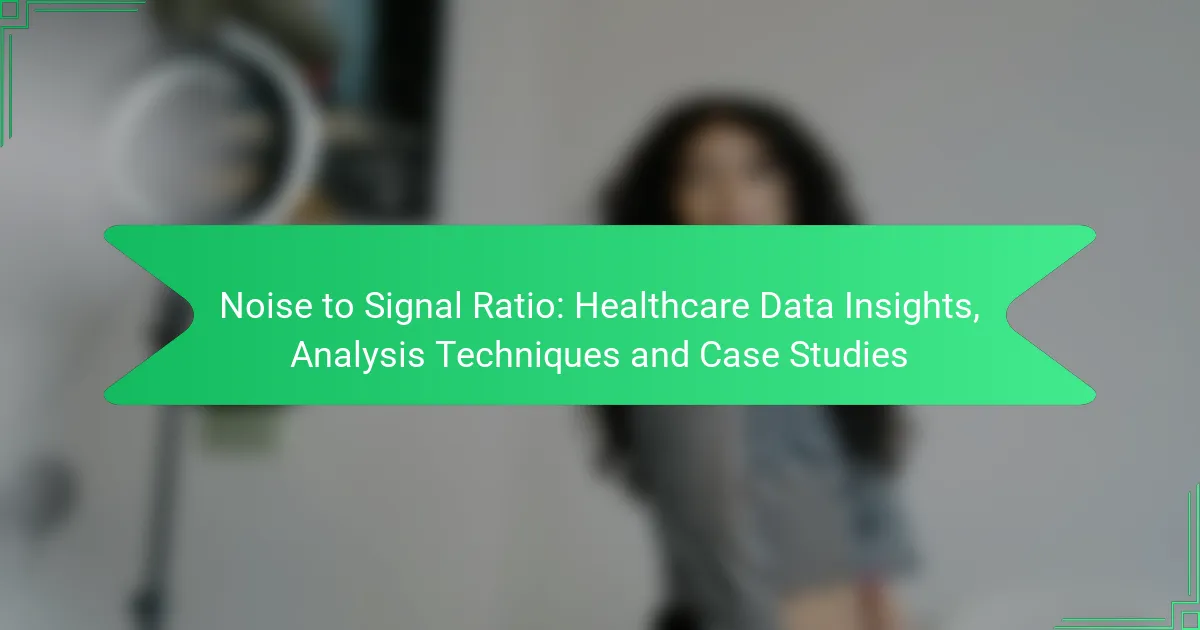The noise to signal ratio in healthcare data is crucial for extracting meaningful insights that drive better decision-making and patient outcomes. By leveraging advanced analytics tools and techniques, organizations can filter out irrelevant information, ensuring that valuable data is prioritized. This approach not only enhances data quality but also supports effective integration across systems, ultimately improving the overall quality of care.

How can healthcare organizations improve noise to signal ratio?
Healthcare organizations can enhance their noise to signal ratio by implementing advanced technologies and practices that filter out irrelevant data while emphasizing valuable insights. This involves utilizing analytics tools, machine learning, and robust data governance to ensure that critical information is easily accessible and actionable.
Implement advanced analytics tools
Advanced analytics tools help healthcare organizations process large volumes of data and extract meaningful insights. These tools can identify trends, correlations, and anomalies that may not be apparent through traditional analysis methods. For example, predictive analytics can forecast patient outcomes, allowing for proactive interventions.
When selecting analytics tools, consider those that integrate seamlessly with existing systems and provide user-friendly interfaces. This ensures that healthcare professionals can easily interpret the data without extensive training.
Utilize machine learning algorithms
Machine learning algorithms can significantly improve the noise to signal ratio by automating the identification of relevant patterns within healthcare data. These algorithms learn from historical data and can adapt to new information, enhancing their predictive capabilities over time. For instance, they can help in diagnosing diseases by analyzing patient records and identifying risk factors.
Organizations should invest in training staff to understand and leverage machine learning outputs effectively. This will maximize the benefits of these algorithms and ensure that insights are translated into actionable strategies.
Enhance data governance practices
Strong data governance practices are essential for maintaining data quality and integrity, which directly impacts the noise to signal ratio. Establishing clear policies for data management, including data entry standards and access controls, helps ensure that only relevant and accurate data is used for analysis.
Regular training sessions for staff on data governance principles can foster a culture of accountability and awareness. This reduces the likelihood of errors that contribute to noise in the data.
Adopt real-time data processing
Real-time data processing enables healthcare organizations to analyze data as it is generated, significantly reducing the noise to signal ratio. This approach allows for immediate insights, which can be critical in emergency situations where timely decisions are necessary.
Implementing real-time processing systems requires investment in technology and infrastructure. Organizations should evaluate their current capabilities and consider cloud-based solutions that offer scalability and flexibility.
Conduct regular data audits
Regular data audits are vital for identifying and eliminating irrelevant or inaccurate data, thereby improving the noise to signal ratio. These audits should assess data quality, relevance, and compliance with established governance standards.
Establish a routine schedule for audits, such as quarterly or bi-annually, and involve cross-functional teams to ensure comprehensive evaluations. This proactive approach helps maintain high data quality and supports informed decision-making in healthcare settings.

What techniques are used for data analysis in healthcare?
Data analysis in healthcare employs various techniques to extract insights from complex datasets, enabling better decision-making and improved patient outcomes. Key techniques include statistical analysis, predictive modeling, data visualization, and natural language processing.
Statistical analysis methods
Statistical analysis methods are fundamental in healthcare data analysis, allowing researchers to identify trends, correlations, and anomalies in patient data. Common techniques include regression analysis, hypothesis testing, and survival analysis, which help in understanding relationships between variables and assessing treatment effectiveness.
For instance, regression analysis can predict patient outcomes based on treatment variables, while survival analysis estimates the time until an event occurs, such as patient recovery or relapse. It’s crucial to choose the right statistical method based on the data type and research question to avoid misleading conclusions.
Predictive modeling approaches
Predictive modeling approaches use historical data to forecast future events, making them invaluable in healthcare for risk assessment and resource allocation. Techniques like logistic regression, decision trees, and machine learning algorithms are commonly used to predict patient outcomes or disease outbreaks.
For example, a hospital might use predictive models to identify patients at high risk for readmission, allowing for targeted interventions. It’s important to validate models with new data to ensure their reliability and accuracy in real-world applications.
Data visualization techniques
Data visualization techniques transform complex healthcare data into understandable visual formats, facilitating easier interpretation and communication of insights. Tools like dashboards, charts, and graphs help stakeholders quickly grasp trends and patterns in patient data.
Effective visualization can highlight key performance indicators, such as patient wait times or treatment success rates, enabling healthcare providers to make informed decisions. When designing visualizations, clarity and simplicity are essential to avoid overwhelming the audience with information.
Natural language processing applications
Natural language processing (NLP) applications analyze unstructured text data from sources like clinical notes, patient feedback, and research articles. NLP techniques can extract meaningful information, identify sentiment, and categorize data, enhancing the understanding of patient experiences and treatment outcomes.
For instance, NLP can be used to analyze patient reviews to identify common concerns or to extract relevant information from electronic health records. Implementing NLP requires careful consideration of data privacy regulations, such as HIPAA in the United States, to protect sensitive patient information.

What are the best practices for managing healthcare data?
Effective management of healthcare data involves implementing strategies that ensure data quality, enhance staff capabilities, and facilitate integration across various systems. These practices are essential for deriving meaningful insights and improving patient care.
Establish clear data quality standards
Setting clear data quality standards is crucial for maintaining the integrity of healthcare data. This includes defining accuracy, completeness, consistency, and timeliness metrics that data must meet. Regular audits and assessments can help identify areas for improvement.
Healthcare organizations should establish protocols for data entry and validation, ensuring that all staff understand the importance of accurate data. For example, using standardized forms can reduce errors and enhance data reliability.
Train staff on data literacy
Training staff on data literacy empowers them to understand, interpret, and utilize healthcare data effectively. This training should cover basic data concepts, data management tools, and the significance of data in decision-making processes.
Regular workshops and online courses can help staff stay updated on best practices and emerging technologies. Encouraging a culture of continuous learning will enhance overall data competency within the organization.
Integrate data from multiple sources
Integrating data from various sources, such as electronic health records (EHRs), lab systems, and patient management software, provides a comprehensive view of patient information. This holistic approach enables better analysis and more informed decision-making.
Utilizing interoperability standards like HL7 or FHIR can facilitate seamless data exchange between systems. Organizations should prioritize investments in integration technologies to ensure that data flows smoothly across platforms, enhancing care coordination and patient outcomes.

What are notable case studies demonstrating effective noise to signal ratio management?
Notable case studies in healthcare illustrate how organizations effectively manage the noise to signal ratio to enhance data utility and decision-making. These examples highlight innovative techniques that reduce irrelevant data while amplifying valuable insights.
Case study: Mayo Clinic’s data integration
Mayo Clinic implemented a comprehensive data integration strategy that combined electronic health records (EHR), genomic data, and patient-reported outcomes. By centralizing diverse data sources, they improved the signal quality in patient analysis, allowing for more accurate treatment plans.
Key to their success was the use of standardized data formats and interoperability protocols, which minimized data noise. This approach enabled clinicians to focus on actionable insights, enhancing patient care and operational efficiency.
Case study: Mount Sinai’s predictive analytics
Mount Sinai Health System utilized predictive analytics to manage the noise to signal ratio in patient data. By applying machine learning algorithms to historical patient data, they identified patterns that predicted hospital readmission risks.
This proactive approach allowed healthcare providers to intervene earlier, significantly reducing unnecessary admissions. Their model emphasized the importance of refining algorithms to filter out irrelevant variables, ensuring that only the most impactful data informed clinical decisions.
Case study: Cleveland Clinic’s real-time monitoring
Cleveland Clinic adopted real-time monitoring systems to enhance patient care while managing noise in data streams. By leveraging wearable technology and continuous monitoring, they gathered critical patient metrics without overwhelming clinicians with extraneous information.
This system prioritized alerts based on severity and relevance, ensuring that healthcare providers received timely and actionable insights. Their experience underscores the need for effective alert management strategies to maintain focus on high-priority patient data.

How does noise to signal ratio impact patient outcomes?
The noise to signal ratio significantly influences patient outcomes by affecting the clarity and reliability of healthcare data. A high noise level can obscure critical information, leading to misinterpretations that may adversely affect treatment decisions and patient care.
Influences clinical decision-making
A high noise to signal ratio can lead to poor clinical decision-making as healthcare providers may struggle to identify relevant data amidst irrelevant information. This confusion can result in delayed diagnoses or inappropriate treatments, ultimately compromising patient care.
To mitigate these risks, clinicians should prioritize data sources with a low noise to signal ratio. Utilizing advanced analytics and machine learning techniques can help filter out noise, ensuring that only the most pertinent information informs clinical decisions.
Affects patient safety measures
The noise to signal ratio directly impacts patient safety measures by potentially masking critical alerts and warnings in clinical settings. For instance, if alarm systems are overwhelmed with non-essential notifications, healthcare staff may overlook vital alerts, increasing the risk of adverse events.
To enhance patient safety, healthcare organizations should implement standardized protocols for data management that focus on reducing noise. Regular training for staff on recognizing and responding to important signals can further improve safety outcomes and ensure that patient care remains a top priority.










